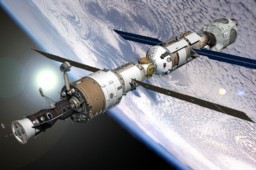
Breathing Easy on the Space Station
| Life support systems on the ISS provide oxygen, absorb carbon dioxide, and manage vaporous emissions from the astronauts themselves. It's all part of breathing easy in our new home in space. |
An artist's rendering of the ISS as it currently appears. |
Many of us stuck on Earth wish we could join (at least temporarily) the Expedition One crew aboard the International Space Station (ISS). Floating effortlessly from module to module, looking down on Earth from a breathtaking height of 350 kilometers.... It's a dream come true for innumerable space lovers
.But be careful what you wish for! Living on the Space Station also means hard work, cramped quarters, and... what's that smell? Probably more outgassing from a scientific experiment or, worse yet, a crewmate.
With 3 to 7 people sharing a small enclosed volume on the still-growing Space Station, air management is critical.
Life support systems on the ISS must not only supply oxygen and remove carbon dioxide from the cabin's atmosphere, but also prevent gases like ammonia and acetone, which people emit in small quantities, from accumulating. Vaporous chemicals from science experiments are a potential hazard, too, if they combine in unforeseen ways with other elements in the air supply.
So, while air in space is undeniably rare, managing it is no small problem for ISS life support engineers.
In this second article in a series about the practical challenges of living in space, Science@NASA examines how the ISS will provide its residents with the breath of life.
